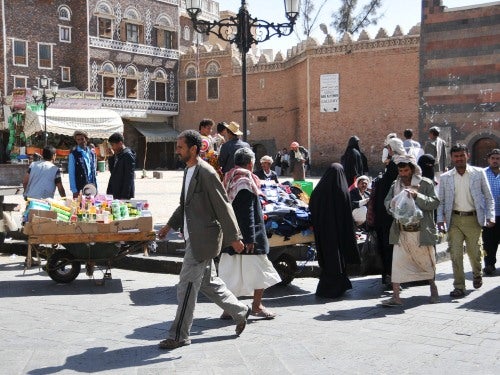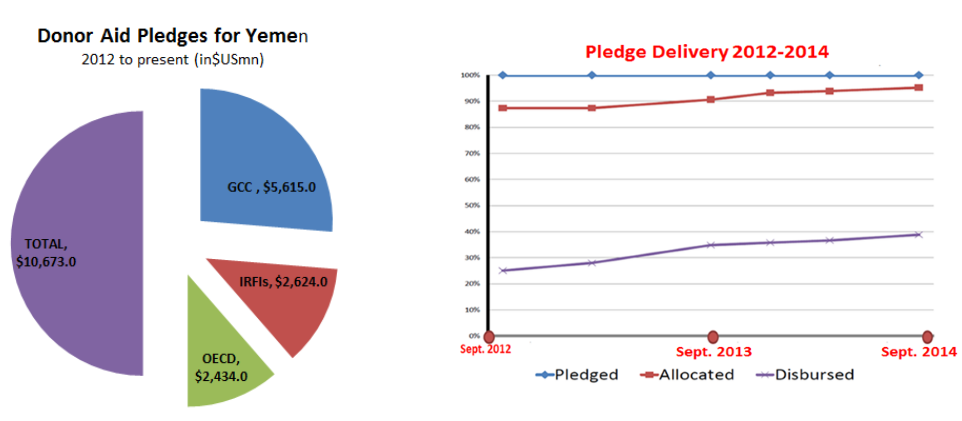 It’s been four years since Yemen witnessed a popular revolt against corruption and injustice. But Yemen has not stabilized since. Back in September 2012, hopes were high that Yemen was on the path to political transition. Aid by the international donor community poured in. But today, Yemenis seem to have lost all hope in government or the impact donor aid could have to improve their prospects.
It’s been four years since Yemen witnessed a popular revolt against corruption and injustice. But Yemen has not stabilized since. Back in September 2012, hopes were high that Yemen was on the path to political transition. Aid by the international donor community poured in. But today, Yemenis seem to have lost all hope in government or the impact donor aid could have to improve their prospects.
The aid landscape in Yemen comprises a small number of donors making large pledges. Arab Gulf donors are at the top of the list giving 50% of the aid Yemen receives, followed by a few OECD countries and international and regional institutions, including the World Bank. Since September 2012, donors have pledged over US$10.6 billion in aid to support Yemen’s transition. But how much of it has actually been delivered? Figures from the government show that only 38% has been handed over, most as direct budget support, namely grants for fuel and a soft loan from Saudi Arabia.
Many government agencies in Yemen lack the technical capacity to process aid quickly and effectively. Donor concern over corruption and aid mismanagement has contributed to mistrust over even direct budget support or social safety nets. Trust and proper technical systems are crucial for scaling-up the disbursement of aid in the country.
Good Social Safety Net programs
And yet Yemen boasts a social safety net program that surpasses similar models in other developing countries. The World Bank has contributed to its institutions. But the government has overlooked the potential for mechanisms like the Social Fund for Development, Public Works Project, the Rural Access Roads Program, and the Social Welfare Fund to absorb and process aid. Those four institutions alone could easily spend half a billion dollars a year and thus contribute to improved aid disbursement.
Such pro-poor institutions maintain trusted relationships with donors. Recognized by the government and the public at large as well, they have ready-to-implement, small- to medium-scale, labor intensive projects across the country. They can easily provide services and much-needed job opportunities to help improve people’s livelihoods. This could have an impact on peace and prosperity.
Donor money has been delivered extremely slowly since September 2012. A complex set of issues contribute to this: a mix of weak government absorption capacity, lack of fiduciary (trustworthy) relationships and governance safeguards, concerns over corruption, and the politics of aid.
Conditionality of Aid
Yemen presents a stark example of what happens when aid is politicized. A three-year Mutual Accountability Framework (MAF) was established to govern the flow aid. It was based on an agreement between Yemen and its development partners. The government committed itself to a set of economic and good governance reforms in return for the timely fulfillment of pledges of aid. Lack of progress on the promised reforms has posed a challenge to the steady delivery of aid.
Over US$2 billion dollars in aid for major infrastructure projects remains blocked. This deprives Yemenis of much-needed, immediate aid. Yet this is not purely a case of technical difficulties and delayed reforms. Fluctuating political relations between some donors and Yemen have also placed the smooth and timely delivery of aid at risk.
False Expectations
The government had bombarded the public with announcements of large volumes of aid money, raising peoples’ expectations. Four years down the line, the average person on the street is seeing the opposite: much of the promised aid has not materialized. This certainly contributed to the recent revolt in September 2014 that led to the demise of the National Reconciliation Government.
The government had failed to communicate the facts both that aid delivery takes time and is driven by politics. Aid follows a process of pledges, allocations, and approval, to project implementation. Timely delivery is crucial to scaling-up aid disbursement.
Slow Pace of Aid Delivery
Aid delivery in Yemen is definitely constrained by the country’s weak absorption capacity. Security and politics come into play as well. The volatile political situation and worsening security are a concern. The recent upsurge in violence has slowed the delivery of aid further and, in extreme cases, led to a complete freeze of it altogether. This leaves Yemen with too much aid on paper and not enough being spent. I wonder for how long?



Join the Conversation